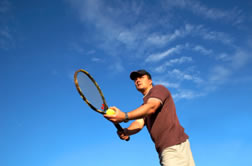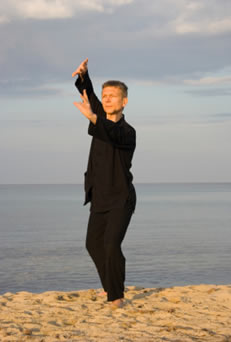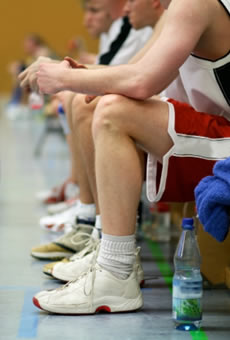Sports Performance: Results
The HeartMath techniques and emWave® heart rhythm coherence training system have been used with great effectiveness to improve athletic performance in a wide range of sports, both professional and amateur. There are numerous case studies illustrating how these tools are being used to improve performance and endurance by individual sports people, teams, coaches and sports psychologists.
“Using HeartMath techniques and the [emWave] system are so effective because you can get immediate feedback on your internal state. Having real-time physiological feedback with the [emWave system] takes the guess work out of whether I’m in the right frame of mind and attitude and gives me something to hang onto—a concrete, internal reference point instead of just guessing at intuition.”
— Marlo Stil, professional golfer
For example, the emWave system is being used extensively in the professional golfing community, as well as by a number of Olympic athletes and teams. A coach with the U.S. Olympic ski team requires his skiers to attain a certain level of heart-rhythm coherence before heading down the slopes. The sports psychologist for the Canadian Olympic teams attended a training program at the HeartMath Institute. He later reported that several of his previous medal-winning athletes on the swim team had cut 0.2 seconds off their swim times after learning how to sustain coherence. And, after coaching a female gold-medalist swimmer in the HeartMath techniques, she went on to set a world record.
In this section you will find a few examples of the type of results athletes in various sports are achieving.
Attaining the Zone: Focus, Control, Flow, and Rhythm Through Resistance
At the height of competition, the ability to manage emotional responses often is the difference between winning and losing. The emWave system provides objective, real-time feedback and allows athletes to better self-regulate their tension and emotional responses, especially in challenging situations. In addition, being able to enter the heart coherence state maximizes many aspects of optimal performance such as eye–hand coordination, reaction times and discrimination.
Entering the Zone
People have talked about “getting into the zone” for years, and “the zone” has become a popular buzzword. Dozens of books have been written on it, but what the zone actually is has been hard to pin down. An air of mystery surrounds it. HeartMath’s research suggests people have within them a place of higher consciousness where life and all sorts of experiences can be processed from another level of intelligence. It’s a state of heart–brain synchronization that is within all people. The zone is not a place you can go to by pushing a button. Rather it is a state of consciousness where your higher motor faculties and intuition merge in liquid coordination.
As people come to understand that the zone is not a one-shot place where they experience some magical peak, but a progressive state of connecting with their intuitive heart, reaching it – over and over – gradually becomes easier.
The emWave system can be used as a preparation before playing or competing in sports, similar to stretching and other exercises. It will help prevent “choking” by adding rhythm to your brain-muscle coordination and providing faster energy recuperation under pressure.
Jimmy Roberts of NBC Sports once asked Tiger Woods: “In the closing holes, as we watch the conclusion of this championship today, what should we look out for? Is there one trouble spot, something that is going to be particular dicey situation for the competitors today?” Tiger Woods’ response: “No, not really. There's some accessible pins, but I think the guys who are really controlling their emotions are going to win; the guy who is controlling his emotions is going to win.”
With a little practice on the emWave system prior to a game or workout or during timeouts to recoup spent energy, players learn to stay in the flow. They develop “rhythm through resistance” or the power to focus, shift and flex when they feel pressing energies, without overreacting or draining their energy. They are able to better focus and direct emotional energy to summon more firepower when they need it on the playing field or during workouts. Learning how to put emotional overreaction in check gives you more power to redirect that emotional energy to a specific goal. This is one of the prime benefits of using HeartMath tools like the emWave system.
Golf
“Feeling has a direct correlation to ease of play, or as I call it, ‘instinctive golf.’ Insecurity and self-doubt can immediately skew your motor skills. The fact is that mental and golf-swing training is often not enough to maintain a consistent emotional balance. You have to address the emotions directly. HeartMath techniques show you how to take control of your emotions, enabling you to make dramatic improvements in your game. I put my students, from top-level professionals and collegians to amateurs, on the launch monitor before and after their HeartMath practice, and most see their club-head speed increase and ball-flight control improve. We also use the software outdoors before hitting real-time golf shots. Again, distance and ball-flight control improve with remarkable consistency. But it wasn’t until I used HeartMath with my family and friends and saw the emotional benefits outside of golf did it sink in for me that something incredible was happening.”
—Joe Thiel, PGA Master Professional; Golf Magazine Top 100 Teacher; Golf Range Magazine Top 50 Teacher; Director of The PGA Golf and Learning Center in Olympia, WA; and certified HeartMath golf instructor.

Ian Woosnam, 2006 European Ryder Cup Team Captain and 1991 Masters Winner, used the emWave along with HeartMath stress-reduction techniques as a way to prepare himself and his team for the Ryder Cup tournament. Golf is what he knows, but he noted, “Captaincy, however, was a bit daunting.”
“Using the emWave Personal Stress Reliever® enabled me to recognize the effects of stress on my body at any given time. Now I can take the pressure out. It helps you ‘get into the zone’ as we players say, and sustain the right frame of mind. My recent tournament performances were helped by the use of HeartMath. It amazed me. emWave can recognize stress levels not otherwise detectable. I wish I had known about HeartMath earlier in my career.”
—Ian Woosnam

Lynn Marriott, a PGA and LPGA Class A professional golfer and co-owner of the prestigious golf school GOLF 54, explains why more pros are using HeartMath to improve their golf game. “At the elite level, poor performance is often a result of indecision. These players all have the technical skill, so that’s not what determines the winner. What’s critical is the ability to make a clear decision about the shot, to be able to sort through all the details and stressors about the course and each particular shot. When a player is grounded and trusts (his or her) intuition about the shot, there is no indecision. Using (HeartMath tools) to shift from your head to your heart throughout your game increases the clarity about your golf shot.
“For instance, use (Quick Coherence® technique) in your pre-shot routine, just before your last look at the target. You get grounded, center in the heart and the feeling comes, ‘Yes, go.’ Sometimes you stand over a putt and you know the ball is going in; other times you stand over a putt and can’t access that same confidence and clarity. (Quick Coherence) helps you access your ‘go’ signals more easily.
—Lynn Marriott

Many athletes speak of “choking” during play. A phenomenon in golf known as “the yips” – it’s an acquired problem of sudden tremors, jerking or freezing while putting – may have both physical and psychological causes, according to a summary of current Mayo Clinic research published in Sports Medicine. Preliminary research indicates more than 25 percent of avid golfers develop the yips, which adds an estimated 4.7 strokes to the average 18-hole score of an affected player. Professional golfers have successfully used the emWave system to manage the yips, stay emotionally balanced during high-pressure putting and lower their scores.
“I learned the (HeartMath techniques) prior to the release of the software/sensor program. Since the [emWave system] came out I've had more fun practicing the techniques and challenging myself. Practicing with the program has helped me improve my ability to quickly shift into the zone. If you're a golfer and haven't learned (HeartMath), you need to and make it fun. Learn it with the [emWave system]! I highly recommend it.”
— Peter Fox, Professional Golf Coach and Author of Natural Golf: A Lifetime of Better Golf
Coaches are using the emWave system to accelerate the results of relaxation, visualization and other mental exercises and to help athletes sustain emotional balance on the field. Health and fitness professionals are recommending the emWave system and using the coherence-building technique because of its performance benefits and ease of use.
“I have found in my life, using the skills of HeartMath and the emWave system, that I am able to get into the zone and stay in the zone,” 2003 PGA Teacher of the Year Laird Small says. “I have also discovered when my students use the emWave system how they are able to control their breathing, mindset and heart rate and get in the zone.”
“HeartMath is the next step in golf,” says Sweden’s premier golf coach, Pia Nilsson, who was responsible for bringing Sweden’s golfers into world-class competition and is the former coach of Anikka Sorenstam as well as the author of Be Your Own Best. Nilsson firmly believes that once golfers have mastered the mechanics of the game, it then becomes a mental/emotional game and HeartMath techniques and emWave technology are the way to lower their scores.
Tennis
A president of a high-tech corporation who would always under perform at a Palm Springs annual tennis tournament, said, “Once I started practicing HeartMath techniques before and during each game, I was able to hit the sweet spot more often and for the first time reached the finals – and won in straight sets!”

National Junior Tennis Players Use emWave system at Tennis Tournaments and See Results
Mike Kennedy, the Tennis High Performance Manager for the Middle States Section had the job of helping to develop professional-level tennis players. To do so, he wanted to help the region's junior players get a competitive edge by enhancing their ability to relax and focus. Being a former competitive player, Mike knew the importance of self regulation and that most players did not have well-honed skills to do this. One of the obstacles he needed to overcome was figuring out how to provide training for this skill in the players' already busy schedules. Collaborating with Angelika Sadar, licensed psychologist specializing in sports, he developed a program in which players would have access to the emWave system technology at selected National Tennis Tournaments.

Several computers with emWave system programs were set up at the tournaments, which were available for players to use between matches. Players quickly learned the coherence techniques and, before long, there were lines of players waiting to train with Angelika and her assistants. Players even began teaching each other the coherence techniques. Being competitors, players also developed ways of challenging each other on side-by-side computers. They raced to see who could get 100% "green" first; or who could get the most points on the pot of gold. They even challenged each other to see who could finish the games with the most seconds remaining! Many players saw benefits of this training during their subsequent match play on the same day Here are some of the comments they made throughout the day of their match play: "This is a way for me to relax while I am playing," "I don't worry when I serve," "I know the breathing helped me win my match," "I had so much more fun playing."
Thanks to Mike Kennedy's progressive thinking, this training has been included as part of the eight Competitive Training Center programs in his section and workshops in the coherence techniques have been offered at several national junior tennis tournaments.
Martial Arts
“It's been largely because of using the emWave technology that I have been able to accomplish all I'm doing. During my championship season, it was essential to relax when I needed to and handle the stress associated with competing and frequent travel to tournaments. Add to this the need to overcome setbacks from injuries and keeping the edge needed to fight in the younger category I competed in. In addition to winning the world championship, I wrote a book and I used (HeartMath techniques) to spark creativity and stay focused on the project.”
—Dennis Kelly, World Martial Arts Champion Master Kelly was inducted into the Martial Arts Hall of Fame in January 2001.

Kelly, author of Six Steps to the Fountain of Youth, writes about how a simple shift in perspective can affect vitality.
“In my 30s, I entered tournaments and won awards in the martial arts, but my life had taken a turn for the worse. Drastic financial problems and having my very ill parents come to live with me had left me devoid of hope and filled with bitterness. “Then one day a friend introduced me to emWave® PC. I recognized that it was in tune with the martial arts centering techniques I’d practiced for years, but it went several steps further! The master trainers had always spoken about the heart, but not in the clear how-to-get-there-and-use-it kind of way. “After practicing the techniques, my whole attitude changed. I realized that there is no reason to let life’s obstacles prevent me from doing the things I loved. I wouldn’t let it get me down. “In January 1997, I came out of retirement and entered competition again. I’m pleased to say that, at 59, I’m the oldest man ever to win a world championship in the sparring division with NASKA (North American Sport Karate Association.) “The curious thing is that when I was 20 years younger the competition was far less intense. I won awards then, but I was mainly fighting with amateurs. Nowadays, pros and masters can compete in the 40+ division. It was a much more difficult challenge to win. Yet, with the focus I gained from this technique, my performance was far better at 59 years old than it had been in my ’30s!”
Team Synchronization
In many sports, success comes from teamwork. “We were on the same wavelength” is a common expression from team players who experienced being in sync with each other and performing at unusually high levels. What they are describing is a type of collective coherence or resonance in which a shared sense of energy, rhythm and intuitive knowing occurs and has a positive effect on how they interact to achieve a successful outcome.
The achievement of successful teamwork or collective coherence is often less then optimal because of individual team members’ personal stress, lack of emotional energy management and ultimately their drain on the collective team energy. When teams use the emWave system before and during practices and before games and use the Quick Coherence® technique during timeouts, they can create personal and team coherence more quickly and this increases intuitive synchronization with each other so they can play “in sync.”
Basketball
“Great results are happening for my basketball team,” high school teacher and sports coach Beth McNamee recalled.
“I had the good fortune to coach an eighth-grade girl’s basketball team. I had watched this group of girls play together as seventh-graders, where they had achieved the record of 6 wins, 7 losses. I noticed their lack of focus, inability to manage their emotions, and limited skill level. As their new coach, my main goal was to help them achieve, individually and collectively, at their highest level of ability. To meet this goal, I expanded their basketball skills and knowledge and taught them HeartMath tools so they could better manage their thoughts and emotions while practicing and competing. Each girl had the opportunity to use the emWave throughout the season.

“The number of turnovers dropped significantly and their shooting percentage increased. Most importantly, they are having fun and are more deeply enjoying the game of basketball as well as each other. They know it’s because of the tools. The smiles on their faces and their increased sense of exhilaration made my heart sing. Boy is this fun!
“The girls were able to step onto the basketball floor with confidence, inner balance and focus. Through practice, they had become more self-aware of their thoughts and emotions and were able to employ the Quick Coherence® technique at any time on the court when they needed to. During the game, each timeout and half-time talk began with a team Quick Coherence. The girls were then prepared to listen and understand with greater clarity. This transferred onto the court, where they were able to execute and perform with great success. This success translated into wins on the basketball court as we ended the season with a record of 15 wins, 1 loss.”
Before each game, the team met in the locker room for a group Heart Lock-In®.
Pre-game Heart Lock-In
Pause thoughts, shift focus away from racing mind to the area around your heart, imagine breathing through the center of the heart, bring in a positive feeling, appreciation for someone or something, feel sense of calm, self security, strength.
Stay with the focus on the heart and positive feeling.
See yourself on the basketball court during warm-ups, feel yourself being focused, energetically balanced, confident, strong, enjoying and appreciating the opportunity to be part of this team and part of this game. See and feel yourself preparing for the game, accurately passing, catching the ball, going strong to the basket, making your lay-ups, swishing your foul shots and moving your feet defensively.
If you make a mistake, a turnover, or an unnecessary foul: Feel yourself recognizing the old tape loop of self-judgment, frustration, anger. Pause that feeling and focus on the area around your heart, bringing yourself back into balance physiologically and emotionally. Feel yourself successfully moving back into sync, focused on the action of the moment and not on the error.
Remember you have the power to manage your emotions and your thoughts. Use Quick Coherence to stop and transform the frustration, nervousness and anger. Use Quick Coherence to transform the negative thoughts, like “I can’t,” to “I can.” Use Quick Coherence to create the biological state of peak performance. Use Quick Coherence to create balance and focus!
Ice Hockey
Ice hockey is an aggressive and fast sport that normally triggers a lot of emotions, including anger, fear and happiness. Our partners at HeartMath Scandinavia AB have been using HeartMath techniques and technology to improve the performance of one of VIK, Sweden’s elite, professional hockey teams. Players find themselves in two positions during a game: Sometimes they are on ice playing, but often they are off in what’s called “the box” waiting for their next play on the ice. The players often feel anxious and frustrated and can have a hard time trying to change their emotional state, especially when they are in the game. In some cases this can be devastating to the team’s overall performance.

Anders Nilsson, CEO of HeartMath Scandinavia AB says, “We started to look at the possibilities of using HeartMath off ice, to transform the players' emotional states from chaotic to coherent. We first used one-on-one coaching with a group of the players while having them on the emWave system. We asked them to experience the negative emotions they experience during games. This helped them to see how these feelings created incoherence, which affects their play. Then we trained them in the Quick Coherence technique and used the emWave system to demonstrate the profound difference in their coherence levels. Next we instructed them to use the time in the box to apply what they had learned to trigger a coherent emotional state. In some cases many players are now using the portable emWave Personal Stress Reliever® during the game to assist them. Now, every time one of these players sits in the box they will immediately make a sincere effort to switch to a coherent emotional state. The results have helped them to be one of the top teams of our professional league Hockey Allsvenskan in Sweden. By practicing HeartMath techniques and using coherence-building technology, the trained players have reported noticing a significant difference in being able to see what’s happening in the game. They also have reported that they have more physical stamina, their legs are fresher, when they have been maintaining a good level of coherence instead of expending a lot of negative emotional energy. Overall the team unity has improved and they are performing at a much higher level than in their previous season.”
Related Links:
For additional support, please see the HeartMath Knowledge Base at:
Support: http://support.heartmath.com
Or, send your question in email to Technical Support Send Mail
